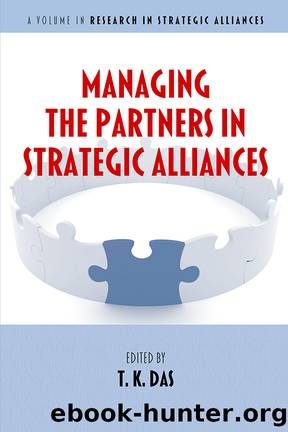Managing the Partners in Strategic Alliances by T. K. Das;

Author:T. K. Das; [Неизв.]
Language: eng
Format: epub
Publisher: Information Age Publishing
Published: 2021-06-30T15:57:03+00:00
Chapter 8
The Influence of Alliance and Partner Characteristics on Tensions in Contractual Alliances in Technologically Turbulent Environments
Diana Marie De Silva
Matthias Vermeiren
Ernst Verwaal
Abstract
The chapter explores the behaviors of partners in technologically turbulent environments that influence the strategic alignment in contractual alliances. In the context of high technological turbulence, the competitive landscape of a firm and its partners in an alliance changes, which requires them to adapt their strategies in order to regain fit. However, little is known about how partner firms in alliances individually and collectively strategize in a turbulent environment. We investigate competing views in the literature and offer propositions which explain how a strategy of an alliance to adapt is contradicted by the partnersâ tendency to protect the individual interests during turbulent times. Building on the resource-based view and dynamic capabilities theory, we look at alliance and partner characteristics and behaviors that can be associated with their strategic decisions. The chapter reports the findings of a qualitative multiple case study of 10 contractual alliances. The investigation focuses on behavioral, structural, and psychological tensions potentially leading to strategic misalignment. In the final section, we offer solutions to manage the predicted partner behaviors to prevent strategic misalignment and alliance instability.
Introduction
Recent decades have shown an exponential increase of technological innovations which spread quickly across global markets. This high rate of technological turbulence âarises from changes in the underlying technologies of products or services and their (increasing) rates of obsolescenceâ (Kandemir, Yaprak, & Cavusgil, 2006, p. 330). This will have a profound influence on how firms do business as the competitive position of a firm is more likely affected, and the competitive landscape of a firm and its competitors is more easily reshaped under conditions of high technological turbulence (Jaworski & Kohli, 1993). Technological turbulence leads to modifications in the dominant design and the alteration of industry standards (Chen, Li, Chen, & Ou, 2018; Kandemir et al., 2006; Tushman & Anderson, 1986) and firms are under pressure to continuously innovate because earlier developed knowledge and technology are not necessarily useful in new market conditions (Amankwah-Amoah, 2017; Chen et al., 2018). Under technological turbulence, alliances are particularly important as they can aid to gain access to new knowledge, pool resources, accelerate time to market, and reduce risk (Anand, Oriani, & Vassolo, 2010; Chatterjee, 2004; Jaworski & Kohli, 1993). The resource-based view (Barney, 1991; Grant, 1991; Wernerfelt, 1984) is appropriate for looking into the formation of strategic alliances because firms often use alliances to gain access to strategic and valuable resources they do not own, but also to protect and leverage their own valuable resources (Das & Teng, 2000a). More particularly relevant in environments of rapid technological change, the dynamic capabilities theory builds on the resource-based view that focus on a firmâs access to complementary assets (Teece, Pisano, & Shuen, 1997) and the value captured from innovations (Anand et al., 2010). Particularly for the case of small firms, the study of Rashidirad, Soltani, and Salimian (2015) suggest that a sustained competitive advantage does not
Download
This site does not store any files on its server. We only index and link to content provided by other sites. Please contact the content providers to delete copyright contents if any and email us, we'll remove relevant links or contents immediately.
Zero to IPO: Over $1 Trillion of Actionable Advice from the World's Most Successful Entrepreneurs by Frederic Kerrest(4053)
Machine Learning at Scale with H2O by Gregory Keys | David Whiting(3627)
Harry Potter and the Goblet Of Fire by J.K. Rowling(3609)
Never by Ken Follett(3528)
Ogilvy on Advertising by David Ogilvy(3332)
Shadow of Night by Deborah Harkness(3174)
The Man Who Died Twice by Richard Osman(2808)
Book of Life by Deborah Harkness(2719)
My Brilliant Friend by Elena Ferrante(2702)
How Proust Can Change Your Life by Alain De Botton(2613)
0041152001443424520 .pdf by Unknown(2595)
Will by Will Smith(2580)
The Tipping Point by Malcolm Gladwell(2559)
How to Pay Zero Taxes, 2018 by Jeff A. Schnepper(2500)
Purple Hibiscus by Chimamanda Ngozi Adichie(2484)
Hooked: A Dark, Contemporary Romance (Never After Series) by Emily McIntire(2421)
Rationality by Steven Pinker(2149)
Borders by unknow(2117)
Daughter of Smoke and Bone by Laini Taylor(2081)
